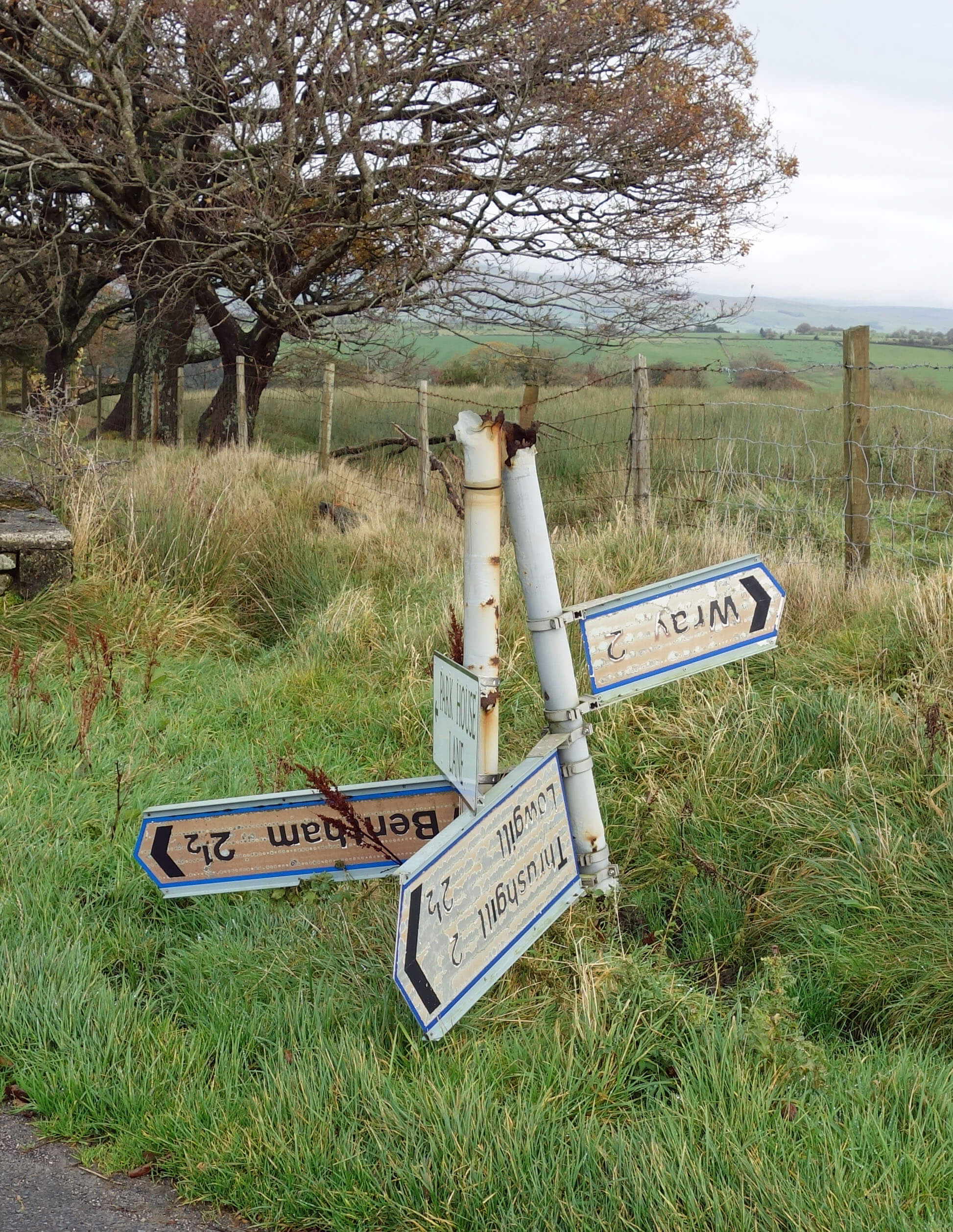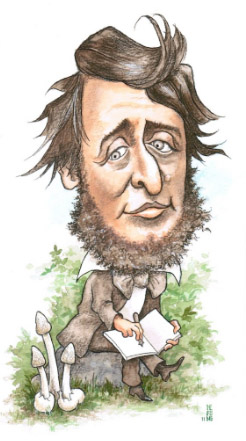

Home Preamble Index Areas Map References Me Drakkar
“I turn round and round irresolute sometimes for a quarter of an hour, until I decide, for a thousandth time, that I will walk into the southwest or west. Eastward I go only by force; but westward I go free.”Walking westward is, he believed, the “prevailing tendency”, a natural inclination or instinct, like being drawn to a magnet of the west.

Under cloud, with the Dales hills to the right and, in the distance, the Lakes hills, in sunshine
So instead I continued on the lofty, lonely, long lane all the way to Wray. Through the drizzle I could see the hills of the Lake District and Yorkshire Dales, the former in sunshine, the latter cloud-topped. As I walked along, the Dales clouds lifted and the Lakes sunshine approached across Morecambe Bay, so I was optimistic that I wouldn't be wet for long, and so it proved. It was uneventful but pleasant enough, looking over the Hindburn valley to the autumn colours of this well-treed region, passing deep green fields for sheep and the red-brown grasses of the untamed moor. In Wray I called in at the garden centre where I found a woman spending gaily (Ruth) and sat in the sun eating my sandwiches.
Cloud lifting from Barbon Fell, Gragareth, Whernside and Ingleborough
Thoreau proceeded to elaborate his ‘west is best’ Theory over several pages. It doesn’t apply only to walkers - whole nations are on the march westward:“That way the nation is moving, and I may say that mankind progress from east to west. We go eastward to realize history and study the works of art and literature, retracing the steps of the race; we go westward as into the future, with a spirit of enterprise and adventure.”The east is the past; the west is the future. He dismissed the contemporary counterexample of Australia because “the moral and physical character of the first generation of Australians has not yet proved a successful experiment”. Thoreau never felt a need or desire to visit Australia – or anywhere else outside North America.

The partially flooded Lune valley towards Hornby from Farleton
As for the causes of the Thoreau Theory of ‘west is best’, he offered two explanations. First, that it is the consequence of “something akin to the migratory instinct in birds and quadrupeds”. Quite why our instinct should be east-west when most migrations are north-south was not explained. Secondly, that we are inclined to follow the sun, which he seemed to consider to be a male deity: “He appears to migrate westward daily, and tempt us to follow him. He is the Great Western Pioneer whom the nations follow.” Unfortunately the sun was beginning to hide behind cloud over Claughton Moor but Thoreau may have a point here. Walkers do prefer to have the sun on their face. However, if we walked towards the sun we would not walk westward. We would walk in a graceful curve that mathematicians could prove to be a parabola, or hyperbola, or what? Left: A signpost that didn't help me walk westward.
Left: A signpost that didn't help me walk westward.
“Columbus felt the westward tendency more strongly than any before. He obeyed it, and found a New World … Where on the globe can there be found an area of equal extent with that occupied by the bulk of our States, so fertile and so rich and varied in its productions? ... From this western impulse coming in contact with the barrier of the Atlantic sprang the commerce and enterprise of modern times ... If the heavens of America appear infinitely higher, and the stars brighter, I trust that these facts are symbolical of the height to which the philosophy and poetry and religion of her inhabitants may one day soar ... Else to what end does the world go on, and why was America discovered?”
 Why indeed? The soaring heights of Americana are everything that make life worth living –
John Dewey, Ezra Pound, Mike Pence, Ernest Hummingbird, Madonna ... But I need to brush up on my history. How do the
civilisations of China, India, Africa, and elsewhere,
including those of the old ‘New World’ (the Aztec, Inca and so on), as well
as the Industrial Revolution, fit in? And why in our inexorable
walk westward should we stop in America? We surely must walk on, westward, westward, across the Bering Strait ...
Why indeed? The soaring heights of Americana are everything that make life worth living –
John Dewey, Ezra Pound, Mike Pence, Ernest Hummingbird, Madonna ... But I need to brush up on my history. How do the
civilisations of China, India, Africa, and elsewhere,
including those of the old ‘New World’ (the Aztec, Inca and so on), as well
as the Industrial Revolution, fit in? And why in our inexorable
walk westward should we stop in America? We surely must walk on, westward, westward, across the Bering Strait ...
“The West of which I speak is but another name for the Wild; and what I have been preparing to say is, that in Wildness is the preservation of the World ... I would have every man so much like a wild antelope, so much a part and parcel of nature.”Can the Earth support eight billion antelopes? Perhaps he meant ants. North America may have the 'Wild West' but it is something of an over-generalisation to equate 'west' and 'wild' everywhere. Given all this nonsense about the West, why should anyone take what Thoreau has to say about the Wild seriously? But some people do, presumably from feeling regret at a perceived loss of wildness rather than from the wisdom of Thoreau's words.
Home Preamble Index Areas Map References Me Drakkar
© John Self, Drakkar Press, 2018-

Top photo: The western Howgills from Dillicar; Bottom photo: Blencathra from Great Mell Fell